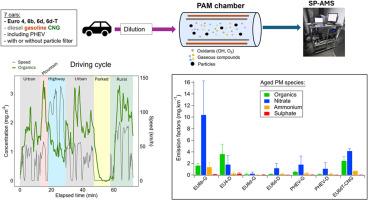从实际驾驶排放到城市空气质量:来自现代柴油、汽油和CNG燃料汽车和插电式混合动力汽车的老化PM组成
IF 3.4
Q2 ENVIRONMENTAL SCIENCES
引用次数: 0
摘要
汽车尾气的二次气溶胶排放通常超过一次颗粒排放,但目前还没有受到监管,因为它们仍然难以限制。本文以最新的欧洲排放标准(Euro 6d)为研究对象,研究了轻型汽车尾气中二次气溶胶形成和化学成分的驱动因素,其中包括混合动力汽车和天然气汽车。七辆现代汽车在底盘测功机中进行了真实驾驶排放模拟循环。废气排放在PAM室中老化,并使用气溶胶质谱仪和最先进的仪器测量其化学和物理特性。结果表明,除旧欧4柴油车外,所有汽车的二次气溶胶排放量都超过了新气溶胶排放量。虽然平均而言,符合欧6d标准的汽油和柴油汽车的PM排放量比老款汽车低90%左右,但它们的冷启动排放量仍然很大。混合动力汽车在转换为内燃机时也会产生相当大的排放量,这取决于驾驶的长度和风格,可以与非混合动力汽车的排放量相当。老化的有机气溶胶主要是典型的环境二次有机气溶胶的氧化化合物,具有不同车型和燃料的独特成分。值得注意的是,CNG汽车排放的类碳氢化合物有机物可能来自润滑油中活性较低的物质,而欧4柴油显示出有机硝酸盐的形成,这是一种在汽车尾气中被低估的成分,对大气有影响。在减排技术中应管制和考虑二次气溶胶及其前体,以最好地减轻城市交通影响地区的大气PM。本文章由计算机程序翻译,如有差异,请以英文原文为准。

From real-driving emissions to urban air quality: composition of aged PM from modern diesel, gasoline, and CNG fueled cars and plug-in hybrid electric vehicles
Secondary aerosol emissions from vehicle exhaust often surpass primary particle emissions, yet they are not currently regulated, as they remain difficult to constrain. Here we investigate the factors driving the formation and chemical composition of secondary aerosol from light-duty vehicle exhaust emissions, focusing on the most recent Euro emission standard (Euro 6d), and including hybrid and natural gas cars.
Seven modern cars were driven through a real-driving emission simulation cycle in a chassis dynamometer. The exhaust emissions were aged in a PAM chamber and their chemical and physical properties measured with an aerosol mass spectrometer and state-of-the-art instrumentation.
Results indicate that secondary aerosol emissions surpassed fresh aerosol emissions for all cars, except for old Euro 4 diesel. While on average, Euro 6d gasoline and diesel cars aged PM emissions were about 90 % lower than emissions from older cars, their cold start emissions were still significant. Hybrid cars also emitted considerably when switching to combustion engine, which, depending on the length and style of the driving, could be comparable to non-hybrid vehicles emissions. Aged organic aerosol was dominated by oxidized compounds typical of ambient secondary organic aerosol, with unique compositions across vehicle types and fuels. Notably, the CNG vehicle emitted hydrocarbon-like organics, likely originating from less reactive species from lubricant oil, and the Euro 4 diesel exhibited organic nitrate formation, an underreported component in vehicle exhaust with atmospheric implications. Secondary aerosol and its precursors should be regulated and considered in reduction technologies, to best mitigate atmospheric PM in urban traffic-influenced areas.
求助全文
通过发布文献求助,成功后即可免费获取论文全文。
去求助
来源期刊

Atmospheric Environment: X
Environmental Science-Environmental Science (all)
CiteScore
8.00
自引率
0.00%
发文量
47
审稿时长
12 weeks
 求助内容:
求助内容: 应助结果提醒方式:
应助结果提醒方式:


